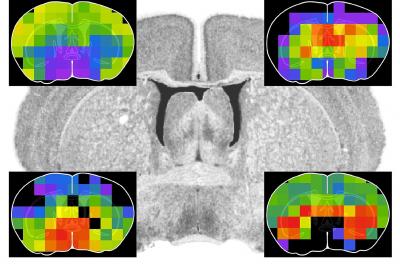The Allen Brain Atlas, a genome-wide map of the mouse brain on the Internet, has been hailed as “Google of the brain.” The atlas now has a companion or the brain’s working molecules, a sort of pop-up book of the proteins, or proteome map, that those genes express.
The protein map is “the first to apply quantitative proteomics to imaging,” said Richard D. Smith, Battelle Fellow at the Department of Energy’s Pacific Northwest National Laboratory, who led the mapping effort with Desmond Smith of UCLA’s David Geffen School of Medicine.
 Caption: Abundance profiles of four different proteins compiled from 1 millimeter cubes (voxels) in a mouse brain.
Caption: Abundance profiles of four different proteins compiled from 1 millimeter cubes (voxels) in a mouse brain.